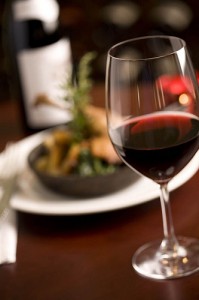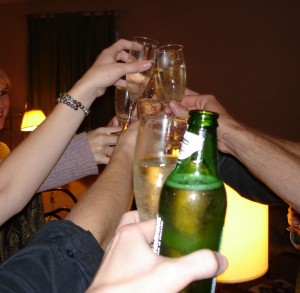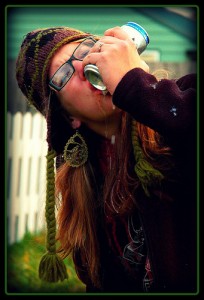In July of last year, The Academic Wino covered a paper that examined the perceived healthiness of wine, and whether or not that perception led to an increase in wine consumption frequency and an increase in willingness to pay for a bottle of wine. The authors found that if subjects believed wine to be healthy, it did in fact increase the frequency of consumption of wine and increased consumers’ willingness to pay per bottle of red wine. One study found that 39%-88% of people in Western countries believe alcohol to be health, particularly when it comes to wine.
The same authors are back again to expand on this finding: what about other motives for drinking? Is the perceived healthiness of wine more important when it comes to frequency of consumption or is taste a more important motivator?
Specifically, the authors sought to examine a variety of motives for drinking and correlate them with drinking behaviors in an adult population, which up until now has largely been studied only in younger populations such as college students.
The study utilized what is known as the “Drinking Motives model”, the purpose of which is to highlight both positive factors (social and mood motives) and negative factors (coping and conformity motives). Some studies have found these motives to correlate with “problem drinking” (not clearly defined as alcoholism), though that has not been the result in other studies. It is also not clear whether or not these motives for drinking change as an individual ages, or if these motives remain consistent throughout an individuals’ life. Some researchers speculate that older people will “grow out” of these motives and evolve different motives for consumption, but there has been little to no evidence presented thus far.
In wine preference research, it is often found that taste is a primary driver of consumption behavior. One study found that younger consumers tend to drink sweeter mixed drinks, while older consumers drink more wines and/or beer. The authors note that one problem with this study is that the “older” consumers were only between the ages of 24-30, which in the grand scheme of things is still relatively young.
In regards to social cues, campaigns are often focused on reducing the levels of alcohol consumed in order to reduce the potential threat of overconsumption and all the negative associations that follow the behavior. In fact, some believe that by promoting alcohol as healthy, this could lead to overconsumption. It is not clear whether this belief is true, and whether or not wine consumption follows the same patterns as other types of alcohol consumption.
The authors of the study presented today aimed to address these questions by examining a variety of motives for drinking in older adults, and whether or not these motives were in any way associated with problem drinking.
Methods
Participants (older than 18 years of age) were recruited into the study by way of an Australian national telephone survey. A wide variety of individuals coming from many backgrounds were selected, filling quotas for race, sex, income, state, and postcode. Those participating were told the study was focused on alcoholic beverages and that questions revolved around alcohol preference, consumption patterns, and other factors that are related to drinking.
The phone survey lasted from 20 to 25 minutes, and included questions related to adult’s motives for drinking (ex. taste and health motives) and possible issues related to problem drinking using the CAGE questionnaire (Cut-down, Annoyed, Guilt, Eye-opener).
The reasons for drinking in this study reflected those outlined in the Cooper’s Drinking Motives model, a model that which states the use of alcohol is driven by the desire to reduce negative feelings and increase positive feelings about consuming the beverage. For this study, reasons for drinking focused on responses to the following:
- “I drink X beverage because…”
- “…it makes me feel good.”
- “…it reduces my level of anxiety.”
- “…it makes me more outgoing.”
- “…most of my friends drink it.”
- “…I like the taste.”
- “…I believe it is healthy for me.”
For determining possible problem drinking, the CAGE questionnaire as mentioned above was employed. This questionnaire is based on four questions:
- “Have you ever felt the need to cut down on drinking?”
- “Have you ever been annoyed by others criticizing your drinking?”
- “Have you ever felt guilty about your drinking?”
- “Have you felt you’ve needed a drink first thing in the morning to steady your nerves or get rid of a hangover?”
The authors note the CAGE questionnaire does not allow for diagnosing alcoholism, and merely characterizes some individuals as “problem drinkers”.
Participants were categorized as being “wine drinkers”, “beer drinkers”, “spirit drinkers”, or “premixed drink drinkers” if they drank that one type of beverage 90% or more of the time.
The goals of the study were to 1) determine the motives behind why participants drink; 2) how do CAGE scores relate to the reasons cited for drinking; 3) how do CAGE scores relate to the type of beverage consumed; and 4) how do beverage type and motive for drinking predict CAGE scores?
Results
Demographics
- 1229 Australians participated in the phone survey with a mean age of 50.13 years (S.D. 16.14).
- Income was highly correlated with age, and was not looked at further in this study.
- 55% of participants were female.
- Women were more likely to drink wine than beer.
- Men drank similar amounts of beer and wine.
- For those preferring a single beverage type, 67% were categorized as wine drinkers.
- 50% of the total participant pool did not prefer one particular type of beverage most of the time.
Motives
- 86% of participants reported that taste was the biggest motivatorfor drinking.
- This result was found for all preferred types of alcohol.
- “Drinking to cope” (i.e. reducing anxiety) and “drinking to enhance well being” (i.e. it feels good) were other common motives reported by participants.
Motives & Problem Drinking
- CAGE scores were significantly different for those reporting internal motives of “enhancing well being” (i.e. feeling good) and “coping” (i.e. reducing anxiety).
- The stronger the motives influence on an individuals’ drinking, the higher the individuals’ CAGE score.
- CAGE scores were significantly different for those reporting external motives of “social” (i.e. more outgoing).
- The more social/outgoing, the higher the CAGE score.
- CAGE scores were not influenced by the external motive of “conforming to a friends’ behavior”.
- “Taste” had no influence on CAGE scores.
- “Health” had a negative influence on CAGE scores.
- Those who reported drinking for health reasons had lower CAGE scores than those not reporting this motive for drinking.
- CAGE scores were significantly different for wine and beer drinkers.
- Beer drinkers had significantly higher CAGE scores than wine drinkers.
- Spirit drinkers and premixed drink drinkers were not included in this analysis, since their subgroup was too small for statistical analysis.
- Controlling for beverage type, men were more likely to have higher CAGE scores than women, and younger drinkers were more likely to have higher CAGE scores than older drinkers (the latter was not significant, but was trending).
What does this all mean?
To sum up, taste was the most important motivator for drinking in this study of Australian adults, with 86% of participants responding in this way. Drinking for health reasons was also a motivator for 24% of participants, who claimed they drink because they perceive the beverage to be good for them. Though some studies have found differences in motivators for younger drinkers, this study did not seem to find these differences, with no statistical differences found between younger and older drinkers when it came to specific motivations for drinking.
In regards to problem drinking, this study found that the desire to change internal states (i.e. wanting to feel good, cope with something, or reduce anxiety) puts individuals more at risk for problem drinking than those influenced by external factors (i.e. social context or peer pressure). These relationships were found to be independent of age and preferred beverage, and for the most part, sex. In other words, it didn’t matter what age participants were or what their preferred beverage type was, they still cited the same motives and scored the same CAGE scores depending upon which motives were cited.
Taste as a motivator was found to not be related to problem drinking, and health was found to be negatively associated with problem drinking. These results seem to indicate that drinking for these positive reasons result in non-overindulgence. Though age was not a factor when considering the internal and external motivators described in the previous paragraph, age was a factor when it came to the motive of health. Specifically, older participants cited health as a reason for drinking more often than younger participants. This is not surprising, considering older individuals tend to have more health problems than younger individuals, thus the desire to focus more on consuming foods and beverages that are beneficial for one’s health.
The authors stress that to those worried that promoting certain types of alcohol as “good for your health”, such as red wine, there should be no concern that this type of advertising will result in overindulgence, according to the results of this study. In fact, those consuming alcohol because they believe it to be good for their health appear to do so in a more responsible manner.
One thing to keep in mind from this study is that the results are only specific to Australian drinkers. It is quite possible that the same study performed in a
different region would present different results. Different cultures have different motivators for drinking, and I would not be surprised if we saw different results in another place (i.e. the United States).
Another limitation to this study is that it only included a small handful of motivators for drinking, and did not include one potentially important motivator for younger drinkers: drinking to get drunk. This motivator is seen in a positive light in the minds of some young people, despite the negative consequences that can occur after the fact, thereby may be an important factor to consider in this type of analysis.
What do you all think of this topic? What other limitations do you see (if any) with this study? Are the authors missing any other big motivators that you think may change the reported outcome? Please leave your comments and participate in the discussion!
Source: Moran, C.C., and Saliba, A.J. 2012. Reasons for drinking wine and other beverages – comparison across motives in older adults. International Journal of Wine Research 4: 25-32.



